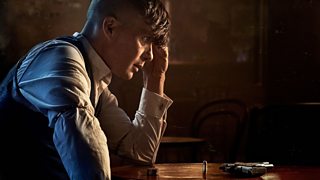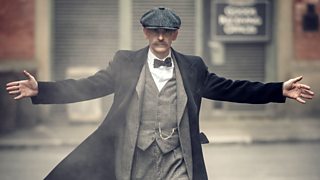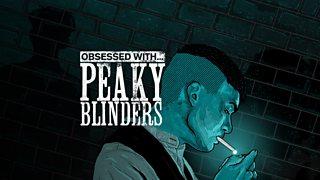The dark, emotional forces that haunt Tommy Shelby in Peaky Blinders are still prevalent 100 years on…

By Matt Allen
From the opening flash of violence in Peaky Blinders series one to the heavy unravelling of lead character, Tommy Shelby at series four’s chilling close, the characters in Steven Knight’s celebrated TV series are dogged by psychological trauma. This was a destructive condition of the times: men — boys really — were sent to World War One in the most brutal conditions, where they were exposed to unimaginable horrors in the battlefields of France. They returned to a more civilised life in England unable to shrug away their experiences. Aggressive outbursts, panic attacks, depression and night terrors were all symptoms of what was then know as shellshock, a condition more recently understood to be Post Traumatic Stress Disorder.

When writing By Order Of The Peaky Blinders with the cast and creators of the hit Â鶹¹ÙÍøÊ×Ò³Èë¿Ú show, I was already aware of PTSD’s influence on the gangland lives and story arcs of the lead characters. Criminal leader Tommy, his sleep shattered by night terrors; his brothers Arthur and John, both forever teetering on the edge of rage; and their former military brother-in-arms, Danny Whizz Bang, a character vulnerable to episodes so psychotic that he murders a man in the middle of a flashback. Having explored the symptoms of PTSD with the former Special Forces soldier, Jason Fox when helping his to write his book, Battle Scars in 2018, I had already explored the insidious effects of what can be a crippling condition.

Throughout his story, Fox describes PTSD as a deceptive force. The stereotypical idea of how the condition manifests itself is of “a veteran cowering underneath a restaurant table at the sound of a car backfiring (or a screaming baby, a dropped plate — anything noisy and unexpected) the classic thousand-yard stare etched into his face as he or she relives a gunfight or IED explosion, the mind unable to tell the difference between the present and a grim and gory past.” The awfulness of PTSD is much more subtle, however. In Peaky Blinders it’s presented through moments of horrific aggression, but Tommy’s bleak detachment from life is a symptom; PTSD can be found in the deadening of emotion that allows Arthur and John to commit sickening acts of harm in a bareknuckle brawl, or an assault acted out with the razorblades stitched into their caps.
“Men came back from World War One traumatised,” said the show’s creator and writer, Steven Knight in By Order Of The Peaky Blinders. “I have an uncle who was there. One time he described a fight he’d once witnessed between two men on a bridge in Birmingham. Apparently it was the most brutal, horrific thing he had ever seen — the two blokes were gouging each other’s eyes out. They didn’t have any limits; the people alongside them in war had been blown to bits by bombs and bullets and their boundaries had gone. Everybody who returned from that conflict did so with a fury inside him.
“I wanted to give the very first episode of Peaky Blinders a theme of wildness that focused on the men coming back from the horrors of the First World War. I’d written Hummingbird, a film with Jason Statham where the plot focused on damaged war veterans returning from Afghanistan. I’d met a lot of Royal Marines Commandos who had come back from there with PTSD — some of their recollections later shaped the personalities and demons of Tommy and Arthur Shelby.”
It’s 100 years since Tommy Shelby returned home at the end of World War One, arguably the most senseless mass slaughter of soldiers in history. But while the body count of modern conflict has been reduced, the psychological impact is just as destructive. Conflicts in Iraq and Afghanistan have left soldiers and their families ravaged by the pressures exerted by guerrilla warfare. In contact situations where troops have stepped into IEDs traps, operated in close hand combat and dealt with a rapidly evolving enemy, the mental aftershocks are too often all-consuming.

“PTSD was slow moving, sluggish,” wrote Fox in Battle Scars. “It crept into the corners of my life, enwrapping my mind and body, emptying me as I became detached, disorientated and indifferent to the things that ordinarily would have brought me happiness — my family, a football match on the TV, a few beers in the pub with mates. Intensifying anger, anxiety and a lack of sleep only added to the internal dread that life had become a pretty rough ride.”
In the time of Peaky Blinders, the stigma attached to shellshock was as debilitating as the condition itself. War veterans often refused to seek help for fear of being dismissed as cowards. In the show, both Tommy and Arthur turn to drugs to drown out their respective demons. Modern service men experience similar issues: pride, the fear of rejection from their fellow soldiers and a loss of self are all obstacles that can hinder treatment. In Battle Scars, Fox details a psychiatric care process in the military that left him struggling to function until he received outside help from a private therapist. From there he was able to move into recovery. Given the statistics (in a recent study, the number of active and ex- service members experiencing PTSD was 6% between 2014 and 2016; between 2004 and 2006 the number was 4%) and the shortfall in aftercare for military personnel experiencing such issues, there is huge level of work to be done.
Tommy Shelby and Peaky Blinders might represent the fictional echo of a brutal moment in British history, but the aftereffects of combat are still very much a psychological problem for returning military personnel. Jason Fox’s turnaround is, at least, a sign of some hope for those in stress.

STATS SOURCE: https://www.theguardian.com/society/2018/oct/08/ptsd-rates-increase-in-uk-military-personnel

